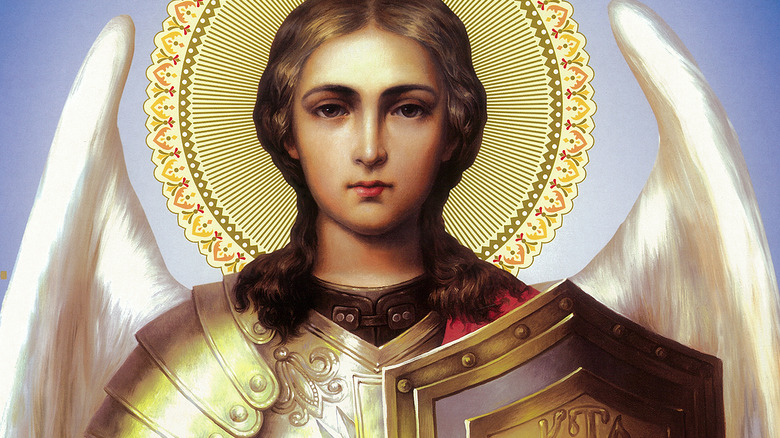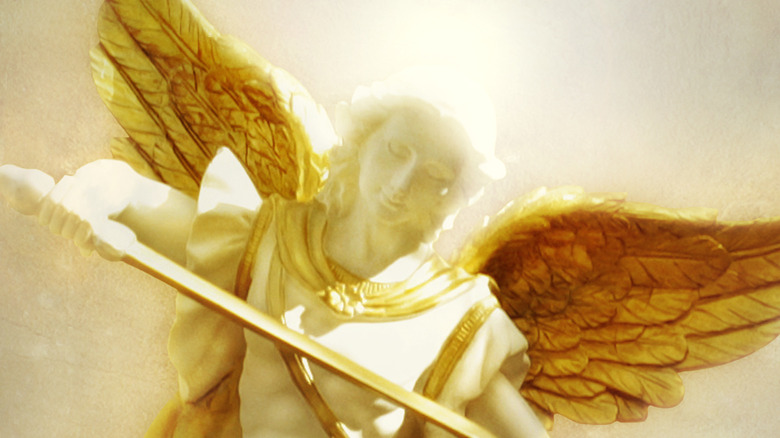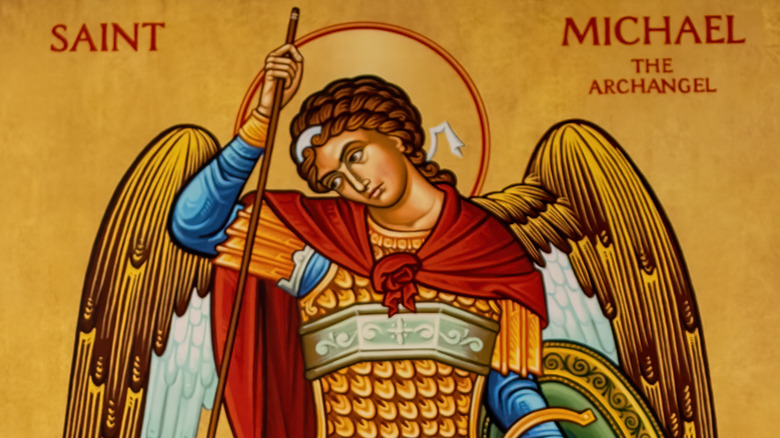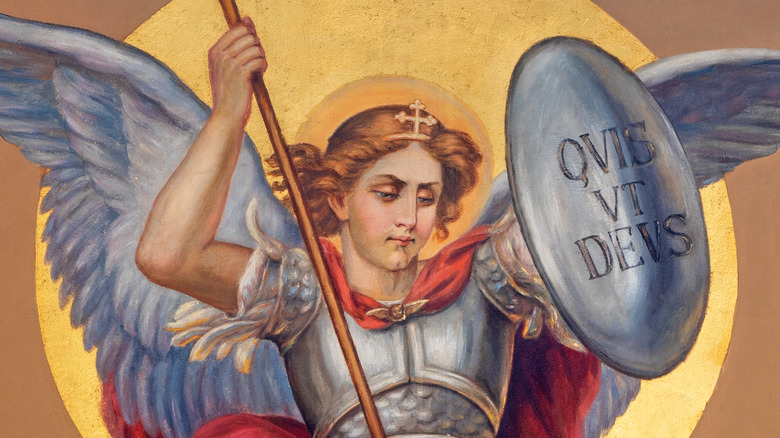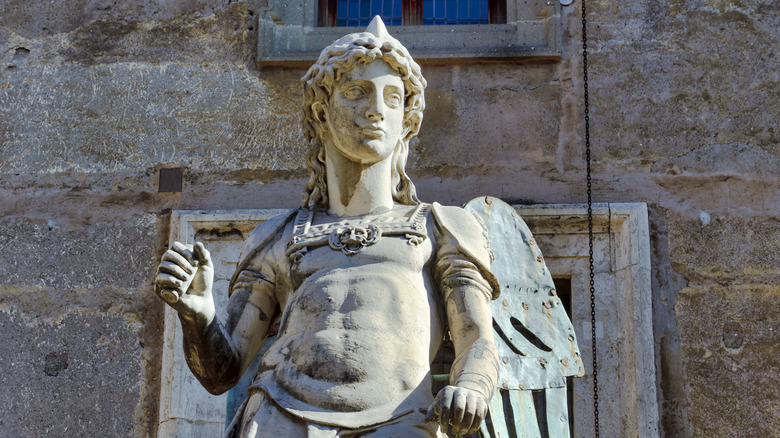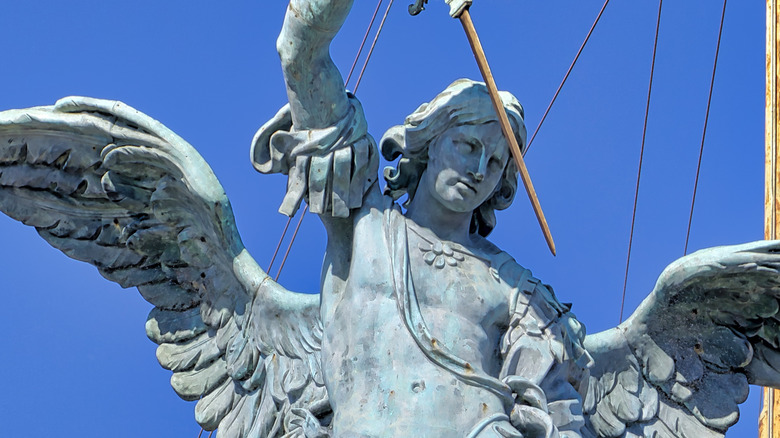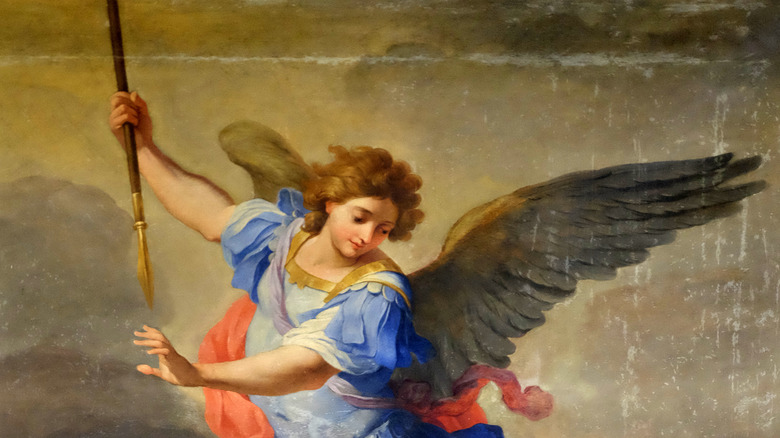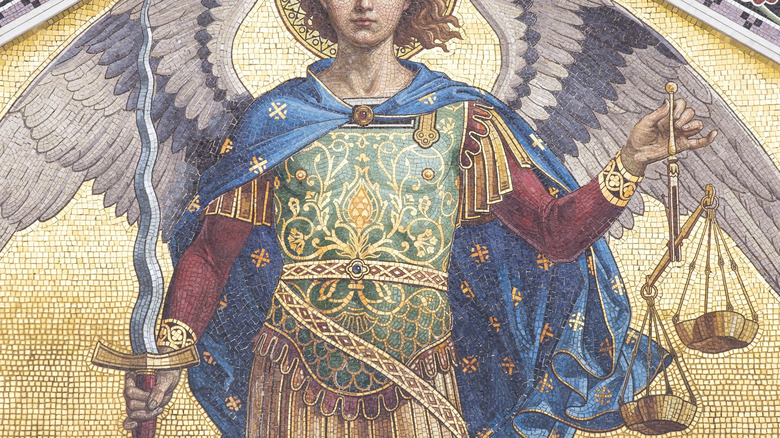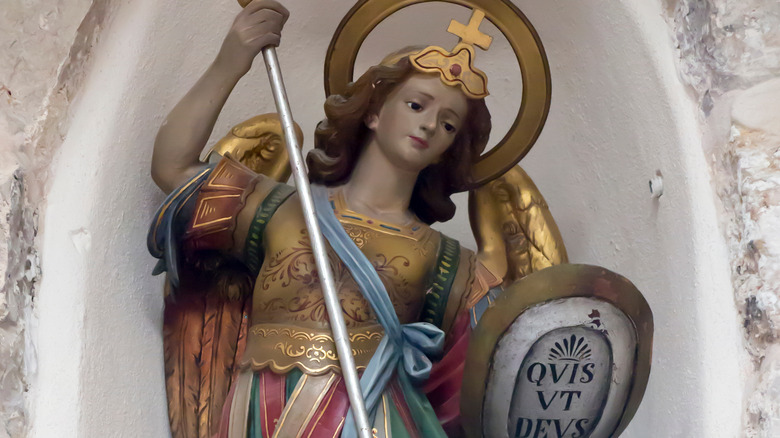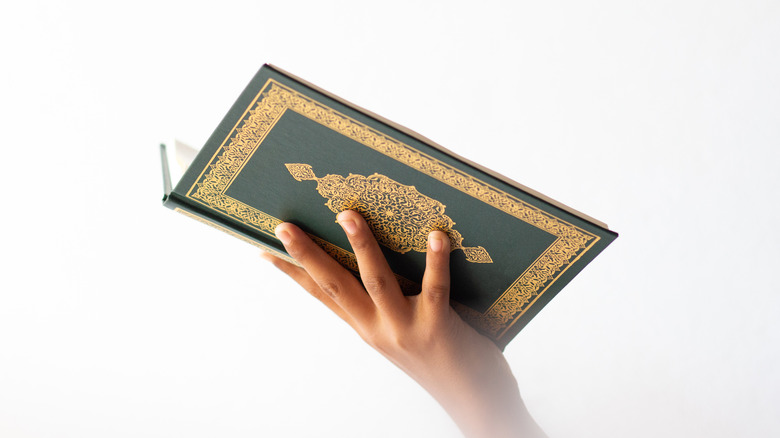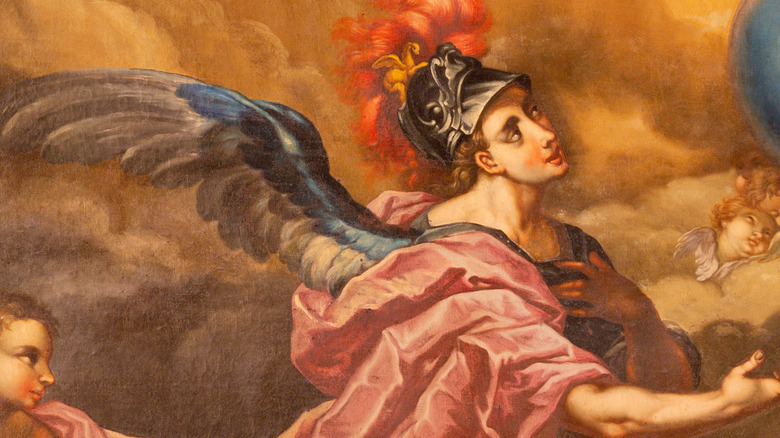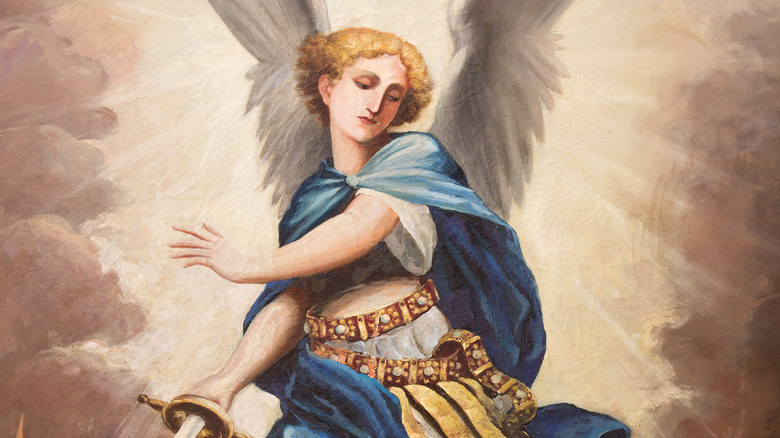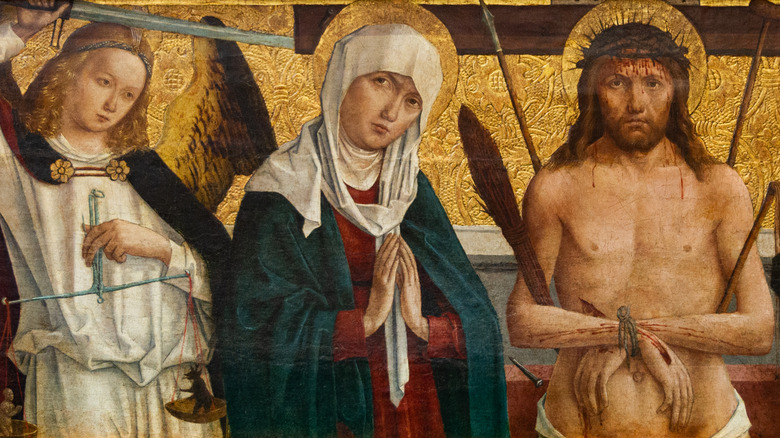The Archangel Michael: The Untold Truth
From the Greek word that literally means "chief angel," archangels are generally regarded as the top brass of the heavenly host. They play important roles in various religions and beliefs: They are spiritual guides in Zoroastrianism, harbingers and messengers in Islam, warriors and scribes in Judaism, and governors of elements, days, and even planets in Paganism.
Among the most well-known archangels is Michael, frequently depicted as the leader of the angelic army. He is also referred to as St. Michael, which may cause some confusion. Michael isn't a saint in the same way certain religious figures are canonized as saints after they die; rather, the title serves as "a sign of respect and honor" (via Dummies).
The archangel Michael's name comes from the Hebrew name "Mikha'el," which translates to "Who is like God?" — a rhetorical question establishing that the Supreme Being has no equal. It's a fitting name, considering how the archangel Michael is the commander of God's army. Here is the untold truth of Michael, arguably the most popular and prominent among the archangels.
Michael: the greatest of all the archangels
Michael the archangel plays a particularly important role in Catholicism. According to the Book of Revelation, Michael was at the forefront during the great War in Heaven, in which the rebellious angel Lucifer and his minions were thrown out of God's kingdom (via Catholic Straight Answers). Some significant religious figures, such as St. Basil and Thomas Aquinas, have even referred to the archangel Michael as a "prince" among the angels.
Michael is one of only three recognized archangels mentioned by name in the Bible. The other two are Raphael (who is introduced in the Book of Tobit) and Gabriel (identified in the Gospel of Luke). The Book of Enoch, which is not officially included in the Catholic Bible, names four other archangels: Uriel, Saraqael, Raguel, and Remiel. Due to the leadership role he holds, many recognize Michael as the greatest among the seven.
Some even argue that Michael is the only true archangel. According to OverviewBible, the Epistle of St. Jude bestows this title upon him; no other named angel in the Bible shares this honor. The idea of other archangels may have stemmed from Michael being called "one of the chief princes" in the Book of Daniel, suggesting that there may be others who share his rank.
Very little is known about the archangel Michael
Despite Michael's prominence, much of his background story is shrouded in mystery. According to Catholic.org, existing knowledge about the archangel Michael is limited to the times his name pops up in the Bible. All in all, the archangel Michael's name appears four times in the religious text: twice in the Book of Daniel, once in the Epistle of St. Jude, and once in the Book of Revelation.
When the archangel Michael is first mentioned in Daniel 10:10-14, the prophet identifies him as "one of the chief princes" revealed to him by a vision. Michael appears a second time in Daniel 12:1–3, where he is said to be the "great prince" who will stand with the people during the end times. Meanwhile, Jude 9 reveals that Michael was "contending with the devil" about the prophet Moses' remains. This mention of Michael is especially significant for two reasons: it is the first and only time Michael is referred to as an "archangel," and it contains the only words Michael speaks in the Bible, directed at Satan: "The Lord rebuke you!"
Lastly, Michael is mentioned in Revelation 12:7, described as the one leading the angels of heaven into battle against the dragon (Satan). The battle ends with Michael and his forces triumphant, throwing the Devil and the angels he recruited down into the fiery pits of hell.
The archangel Michael's power reaches the physical realm
The archangel Michael's mentions in the Bible have helped establish him as the top dog of the angels, which suggests that he's quite powerful in the heavenly realm. Interestingly, Catholics have alsohistorically regarded him as a powerful force even on Earth — and have even invoked his name in prayers and religious ceremonies.
According to Catholic Straight Answers, the founding fathers of the Church strongly believed that the archangel Michael played pivotal roles during monumental events in the history of Catholicism. For starters, they raised the possibility that Michael was the angel guarding the entrance to the Garden of Eden, ensuring that the first man and woman would not be able to enter once more after they were cast out. Michael may have also been the messenger who published the Ten Commandments, and is also believed to have decimated the Assyrian king Sennacherib's army and blocked Balaam's way after the prophet incurred God's ire. Historical Egyptian Christians also held a feast for the archangel Michael patterned after the Greek celebration (which falls on November 12), entrusting the Nile river's safety and life-giving properties to the heavenly warrior (via NewAdvent.org).
Nowadays, the archangel Michael's name is typically invoked in exorcism rites (especially when done to kick demons out of certain locations), as well as in various prayers. One notable example is the Tridentine mass version of the Confiteor, a prayer of acknowledging one's sins and repenting for them.
The archangel Michael has four major responsibilities
Based on the instances in which Michael the archangel was mentioned in the Bible, Catholics believe that the chief prince fulfills four important roles (via Catholic Straight Answers).
As the guardian of the Church, it is the archangel Michael's responsibility to protect believers' souls from Satan's power, particularly when they are about to die. Related to this and to the account of the War in Heaven, Michael is also the archnemesis of Satan and the former angels under his command, tasked with leading the angels in fighting the legions of hell up until the end times.
Thirdly, he is the archangel of death, whose job is to ensure the safe passage of the souls of the faithful departed from the earthly realm to the Lord's presence. In "Michael: Communicating with the Archangel for Guidance & Protection," author Richard Webster writes that the archangel also gives the dying one last shot at redemption, to Satan's immense dismay. His final responsibility is to be the protector of God's people: the Jews in the Old Testament, and the believers of today.
The archangel Michael: venerated as a healer
It may sound odd for an angelic army commander to be connected to healing, but that's exactly how the archangel Michael has been perceived by believers for centuries.
Numerous accounts exist of the faithful invoking Michael's name for healing and protection. For instance, when a fearsome plague hit Rome in 590, Pope St. Gregory the Great spearheaded a procession of atonement and penance through the city. At that moment, the archangel Michael reportedly appeared at the Castel Sant'Angelo (also called the Tomb of Hadrian) and ended the plague. A marble statue of the archangel was erected to mark the occasion; a bronze statue of Michael eventually replaced it. There's also the Michaelion, a sanctuary at Sosthenion that was reportedly built by Constantine the Great after the archangel appeared to him in a vision (via NewAdvent.org). It is said that ailing devotees would spend the night at the Michaelion, hoping for a vision of the archangel and for healing of their afflictions.
Interestingly, the Jews entrusted their sick, not just their military victories, to the archangel. Part of what spurred this belief was a story about the sudden appearance of a "medicinal spring" at Chairotopa, near the ancient city of Colossae in Phrygia. According to legend, bathing in the spring while invoking the names of Michael and the Holy Trinity cured many believers.
The archangel Michael versus Lucifer, the Lightbringer
The archangel Michael is perhaps best known for being the constant thorn in Satan's side. As the commander of the angelic army, Michael is the devil's direct enemy, and is often depicted triumphing over his foe (usually in dragon form) in various works of art, with spear or sword in hand (via Saint Michael's College).
According to Christianity.com, there are two chapters in the Bible believed to be describing the downfall of Lucifer, the former "lightbringer" of heaven. Verses from Ezekiel 28 tell the story of a magnificent being whom God "anointed as a guardian cherub," until "wickedness was found in [him]" when he schemed to usurp the Creator's throne. Meanwhile, Isaiah 14:12-15 references how the "morning star" fell so low, cast out of heaven and "brought down to the realm of the dead, to the depths of the pit."
The few accounts in the Bible pertaining to the archangel Michael and Lucifer cover the full extent of what Catholics know about their eternal battle. Interestingly, the TV show "Lucifer" has a unique take on this Biblical rivalry by portraying Michael as Lucifer Morningstar's twin brother. The show, which takes inspiration from the DC comic books created by Neil Gaiman, reveals that Michael was actually the architect of Lucifer's downfall, as he envied his brother for being the apple of God's eye.
The archangel Michael's arsenal
As the warrior leading the angelic army into battle, the archangel Michael is often shown as a "knight-warrior" decked out in armor and brandishing powerful weapons (via Catholic Straight Answers).
According to NewAdvent.org, illustrations of the archangel Michael typically have him wearing a helmet, with a sword in one hand and a shield with the Latin inscription "Quis ut Deus" in the other. Less frequently, some works of art highlight his role in the final judgment by equipping him with either the Book of Life or a pair of weighing scales (for weighing the souls of the departed). His nemesis in most of these depictions is often Satan in dragon form, usually defeated and lying at the archangel's feet. Sometimes, Michael is shown goring the creature with a lance or spear; these images usually feature the archangel pairing his weapon, which bears a red cross and a linen ribbon, with a green palm branch in his other hand (via Serbian Orthodox Church).
Interestingly, there is an actual sword of St. Michael, though it's not quite the weapon you'd imagine. As The Catholic Travel Guide explains, this "sword" is formed by tracing seven monasteries associated with the archangel on a map: Skellig Michael in Ireland, St. Michael's Mount in England, Mont Saint Michel in France, Sacra di San Michele in Italy, Sanctuary of Monte Sant'Angelo in Italy, Panormitis Monastery in Greece, and the Stella Maris Monastery in Israel.
St. Michael: The guardian and intercessor of Israel
In the book of Daniel, a vision reveals to the prophet that the archangel Michael (described as a "great prince") will play a role in the deliverance of the people of Israel. OverviewBible clarifies, however, that it's not entirely clear what the archangel's role will entail. Nevertheless, it has helped forge the idea that Michael would act as an advocate of the Jews, and that he may even serve as a "high priest" who would help them attain salvation at the end of the world (via the Jewish Encyclopedia).
In an earlier passage in Daniel, an angel appears before the prophet, who had been mourning and fasting for three weeks. The otherworldly being explains to Daniel that a battle against the kings of Persia had delayed his journey to the prophet, and that it was only through the intervention of Michael that he was able to continue his journey and deliver this message. He then warns Daniel of what lies ahead for the Jews, but stops to return to the fight he had left, adding that the archangel Michael was his only ally in that battle.
Traditionally, angels are not supposed to play any part in mediating between God and the chosen people, which makes Michael's role as Israel's guardian and advocate unique. As the Jewish Encyclopedia explains, this has also led to the creation of two prayers directly asking Michael to be Israel's intercessor.
The archangel Michael in the Quran
As the BBC explains, the archangel Michael also plays an important part in Islam. Known as Mika'il, the angel is associated with divine providence and food security, due to his role as "the giver of rain." Similar to his role as Israel's guardian, Mika'il is also recognized as "the Angel of Mercy," often interceding on humanity's behalf so that Allah may grant them salvation. Additionally, Mika'il acts as a guardian angel, keeping sacred grounds safe and rewarding kind acts.
Out of all the archangels, only Michael and Gabriel (Jibril) are explicitly mentioned by name in the Quran, the holy book of Islam. In Quran 2:98, the two archangels are established to be on Allah's side against "disbelievers." The Muslim faith also establishes the existence of other major angels: Izra'il or Azrael, called the Angel of Death, and Israfil or Raphael, who "will blow the trumpet on the Day of Judgment" (via Sydenham School).
According to Sunnah.com, the Islamic prophet Muhammed met both Mika'il and Jibril, with the former sitting on his left side and the latter on his right. During this encounter, the angels asked him to recite the Quran until he reached seven modes. Interestingly, Mika'il is described as a serious angel by Jibril, who reportedly said that he "has not laughed since the creation of the Hellfire" (via Daily Hadith Online).
The archangel Michael: the patron of soldiers, police officers, and doctors
Aside from the times in which the archangel Michael is directly mentioned in Catholic lore, there are many other victories in the name of God that are believed to have happened under his leadership. For this reason, the angelic commander is regarded as the patron of those in the military and in the police force — and given his historical association with healing, he is the patron of doctors as well (via Catholic.org).
Those three sectors of the community are not the only ones who seek out the archangel Michael for protection, though. According to a list by Catholic Saint Medals, Michael is also the patron of holy death, sailors, paramedics, and EMTs. By order of Pope Pius XII in 1941, the archangel also became the patron of radiologists. Perhaps due to his role as guardian, people who require aid in fighting temptation also turn to Michael. As a feature by St. Patrick Parish put it: "[St. Michael the Archangel is a] champion of all Christians, and the Church itself."
The archangels' feast day is named after St. Michael
According to an article published by Franciscan Media, devotion to the archangel Michael predates all other angelic devotions, tracing its roots to 300 to 400 A.D. in the East. A century later, the Western Church began observing an annual feast day honoring Michael and the other angels: Michaelmas, short for "Michael's mass" (via Merriam-Webster).
The Feast of St. Michael's elaborates on the history of the celebration, which is observed every September 29. Michaelmas is said to be the "Christian equivalent of the autumn equinox," marking both a change in weather patterns and a starting point for many important sectors of society. For the English, Michaelmas often meant that it was time to elect new officials, begin the academic and fiscal years, and hire new servants. Meanwhile, the Irish liked to fish on Michaelmas, believing that good luck would bring them a great catch.
A three-day fast prior to Michaelmas was also enacted into law back in 1014, during which servants were prohibited to work. Interestingly, paying rent coincided with Michaelmas, with food (typically a goose) becoming the preferred currency. The Isle of Skye parish even held a procession on Michaelmas, complete with a special cake called St. Michael's bannock (via NewAdvent.org).
Were the archangel Michael and Jesus Christ one and the same?
For Christians, the distinction between the archangel Michael and Jesus Christ is clear: The former is the battle commander of God's angelic host, while the latter is the son of God who died on the cross for the sins of the people. However, some believe that Michael may be more than just an archangel: He may actually be Christ himself before becoming human and after rising from death.
Based on their interpretation of how Michael is described in the Bible, Jehovah's Witnesses believe that the archangel and Christ are one and the same (via the Watchtower Online Library). They cite Michael's depiction in the Epistle of St. Jude as "the only archangel" as proof: "This suggests that there is only one such angel. In fact, the term 'archangel' occurs in the Bible only in the singular, never in the plural" (via Jehovah's Witnesses). They also cite 1 Thessalonians 4:16 as proof of Christ's association with the term "archangel," as the verse describes Christ descending from heaven "with an archangel's voice."
Meanwhile, the Church of Jesus Christ of Latter-day Saints upholds that the archangel Michael was actually the first man, Adam, before he became mortal. They base this partially on how they interpret the meaning of his Hebrew name. However, they also recognize his role as angelic commander and Satan's chief enemy, and regard Jesus Christ as a separate entity.
